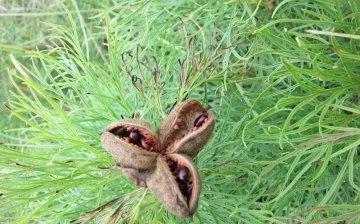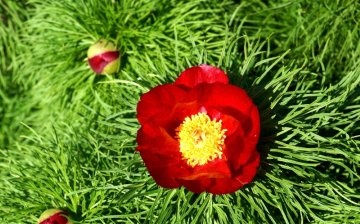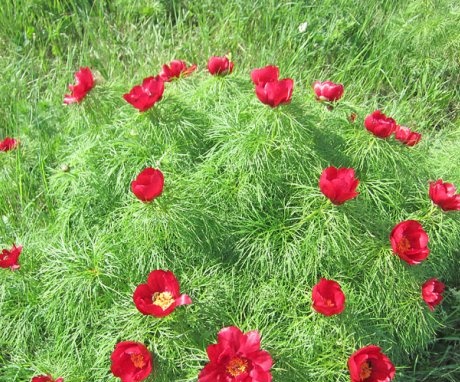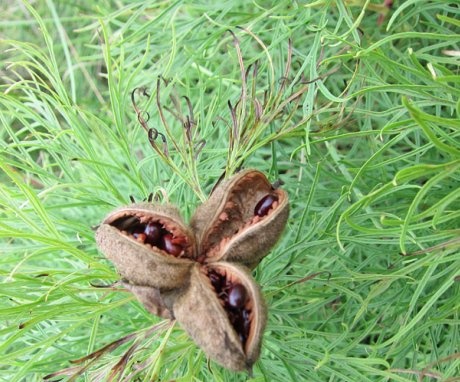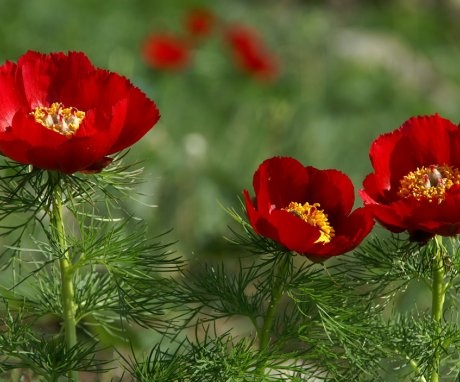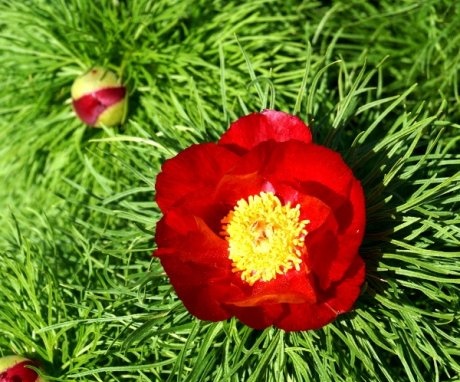Thin-leaved peony in the garden - from planting to leaving
At the moment, the thin-leaved peony is listed in the Red Book of the RSFSR. Previously, this plant could often be seen in the steppes and forest-steppes of Russia. Now it is a very rare flower, it grows in the southern regions of Russia: in the Belgorod, Voronezh, Tambov regions. Blooms pion in early spring, and in the Moscow region - in mid-May.
Content:
- Features of the structure of the peony thin-leaved
- Reproduction and planting
- Care Tips
- Pests and diseases, the fight against them
Features of the structure of the peony thin-leaved
Description of the peony variety:
- It looks like a bush with dozens of buds in bloom.
- Flowers of a rich scarlet or crimson hue with yellow anthers, they are not very large, their diameter is up to 8 cm.
- The bushes bloom for only a few days.
- The bush grows up to 40-45 cm.
- It has a hemispherical shape and delicate leaves.
Terry forms of peonies are very beautiful. These forms of peonies bloom for up to 17 days. By July, the bush decays. By August, its entire ground part dies off, the bush will grow back only by the end of next spring.
Peony prefers light, drained soil that has neutral or slightly alkaline characteristics.
They should be moderately moist or dry. Chernozem, which has a high content of calcium carbonate, is best suited for the plant. The thin-leaved peony loves both bright rays of the sun and partial shade.
If the soil is acidic, then pour a glass of dolomite flour or lime, 2 cups into the hole when planting ash, 100 g of superphosphate, 50 g of potassium sulfate. This fertilizer lasts for several years.
Reproduction and planting
Thin-leaved peony propagates by cuttings and seeds. Perfectly suited for reproduction of a division of 2 adventitious roots, having a length of 5-6 cm and a thickness of about 1 cm, and 3-4 more developed buds of renewal. It has an optimal amount of useful elements that are needed for rooting and growth.
Landing rules:
- Dig holes 60x80 cm in size, observing the intervals between them in 1 m.
- Place a layer of drainage on the bottom of the pit.
- Then make a mixture of garden and peat soil, compost and integrated mineral fertilizer with ash. Instead of a complex mineral fertilizer, you can use rotted manure.
- Put a mound of earth into the hole.
- Place a plant on a mound.
- Burying pion, keep in mind that the apical bud should not be lower than 6-7 cm from the surface, otherwise it will not bloom.
- Delenki during planting should not be buried. Renewal buds should be about 5 cm from the soil surface.
Reproduction by seeds. The seeds cannot lie, as they quickly lose their germination, because of this, they are sown in the ground immediately after harvesting or in October, before that time they were put in the refrigerator, where they lie all summer. Seedlings grow in the next spring, but they can appear in a few years. It is best to sow seeds that are not yet fully ripe. But the peony is rarely propagated by seeds, since with such a sowing up to flowering peonies 5-6 years pass.
Care Tips
With proper planting and preparation of the soil mixture in the first 2 years, peony bushes do not require sprinkling fertilizers... During this period, peonies need to be weeded, loosened and watered.
Features of caring for a thin-leaved peony:
- Loosening the soil. You need to loosen the soil very carefully around the bushes.Loosen the ground by 5-7 cm close to the bush, and having retreated from the peony by 20-25 cm, it is already allowed to loosen the soil to a depth of 10-15 cm. If you constantly loosen the ground, an aerated layer will be created that will prevent the evaporation of water from more deep layers of soil. Then the peonies will not need frequent watering. Loosen the soil after watering and rain.
- Watering... Water the peonies liberally once a week. Pour 3-4 buckets of water under each bush. It is especially important to water the peonies in the spring and early summer, as at this time they grow intensively and lay buds. In the second half of summer, the plants should be watered so that the buds of renewal are formed correctly. If the peonies are not planted very densely, then make grooves at a distance of 10-15 cm from the plantings and pour water into them. If the peonies have grown very much, then dig grooves, stepping back from the flowers of 17-20 cm. It is best to pour water into the grooves in the evening, since at this time the moisture evaporates minimally from the soil surface, and, therefore, a large amount of water is absorbed by the roots. If it's hot, water the peonies every day from a watering can. Do not water the flowers with sprinklers, as this contributes to the emergence and development of fungal diseases... If you do not drain or plant peonies in the lowlands, the flower may get wet in spring. Also, with spring frosts, flower buds can be damaged. The peony is thin-leaved frost-hardy, it is not covered for the winter.
- Blooming buds. If in the first 2 years you see buds on plantings, then cut them off so that the peonies spend nutrients on the growth and development of roots, and not on flowering. 3 years after planting, the bushes grow 10-15 stems, they bloom. To keep the flowers large, cut off the side buds that have reached the size of a pea.
- Top dressing... When feeding, phosphorus and potassium should prevail. Excessive nitrogen fertilization leads to a reduction in the number of flowers, lodging of stems and fungal diseases. 3 years after planting in the spring, the peonies are fed with urea and ammonium nitrate (about 50 g per bush). When flowering in the summer, peonies are fed with complex mineral fertilizers, and at the beginning of autumn, phosphorus and potassium are used. If the bush has been growing for 9-15 years, then increase the amount of mineral fertilizers by 1.5 times when feeding. It is good to feed such bushes mullein... But you need to make sure that the mullein does not fall on the roots.
- Transfer... It is best to replant the bushes in late August - early September.
Pests and diseases, the fight against them
Common pests of fine-leaved peony:
- Peonies can be attacked by bronze beetles, these are shiny and bright beetles. They eat flower petals as well as pistils and stamens. If there are many beetles, then spray bushes with hellebore infusion or any insecticide.
- Gallic roots may also appear on the roots. nematodes, they contribute to the nodular swelling of the rhizomes. For prevention, harvest and burn plant tops, dig up the ground when applying mineral fertilizers.
- Sod ants drink juice from buds and eat flower petals. To get rid of them, spray the bushes and the ground with deterrent drugs.
- In addition to them, the caterpillars of the scoop butterflies eat the buds of peonies. Spray the bushes with insecticides to eliminate pests.
Peony diseases:
- Peonies can be affected by gray mold. To prevent the disease from appearing, you need to weed and water the plants in a timely manner, loosen the ground. Spray the ground in early spring fungicides.
- Rust can be detected by the yellowish-brown sporulation of the fungus on the underside of the leaves. Peonies can also develop brown spotting. Therefore, it is required to collect and burn the tops; when signs of disease appear, spray the bushes with Bordeaux liquid.
- Powdery mildew identified by a white coating that resembles flour. Collect and burn all plant residues.Spray the bushes with a solution by dissolving 20 g of copper sulfate and 200 g of green soap in a bucket of water (10 l).
To prevent diseases from hitting peonies, plant them away from other bushes, trees, houses. Thin-leaved peonies are planted in large rock gardens, they look beautiful among stones. Peony goes well with perennial flax, cereals, eremurus, granular saxifrage, broom.
More information can be found in the video:





